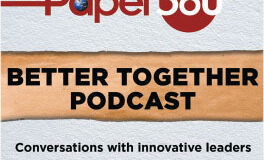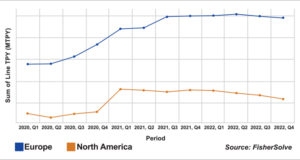Food packaging is increasingly impacted by the drive for sustainability, the issues with plastic waste, and the growing rate of urbanization and related phenomena, such as the take-out culture. Current megatrends seem to present a golden opportunity for the fiber-based packaging industry, but what does the future of food purchasing and packaging look like? A recent scenario report published by global chemicals company Kemira identifies four futures.
“We wanted to explore the possible outcomes of the trends that are visible in the market today and provide some food for thought for the players in the packaging value chain,” says Senior Vice President Antti Matula, who is leading the Global Product Lines and Business Development for the Pulp and Paper segment at Kemira. “As a chemical supplier to the pulp and paper industry, we are an important part of the value chain for fiber-based packaging. Chemistry is needed for creating virtually every characteristic of the paper and board used in food packaging. Often, the advanced chemistry and technology behind the solutions remain unseen.”
To paint a picture of what food and its packaging could look like in 10 years’ time, Kemira reached out to industry experts, researchers, and key stakeholders: paper and board manufacturers, packaging converters, brand owners, and regulatory experts. Based on their insights, four plausible alternatives for the future were created using the qualitative Delphi forecasting method.
The four scenarios discuss consumer attitudes and behavior, places and ways of purchasing food, food packaging, recycling schemes, and regulation. What kind of opportunities and challenges could each of them mean for the fiber-based packaging value chain if they become a reality?
Scenario 1:
Unique Packaging is King
In the first scenario, titled Individualism to the Max, the food industry fragments to serve a vast variety of consumer tastes and interests. The food—and its packaging—are an important part of identity building, and consumers make decisions driven by their personal values and beliefs.
In this environment, unique packaging is king. “Packaging materials are used in high volumes and varying mixes, and brand owners are willing to make material choices that would be considered bad in today’s sustainability focused market—in the name of brand differentiation,” says Matula. “If this would be the case, the paper and board industry needs to increase its efforts and develop packaging solutions that can be used in an even broader set of applications than today.”
Food packaging needs to deliver both the experience and the information to support the purchasing decisions of individualistic consumers. This could mean increased requirements for customizability, printability, and brand expression on packaging, and also new digital solutions. “What about a chip embedded in the packaging telling the product’s story or chemical composition of the packaging that could visually indicate the level of hygiene or shelf life left for the product inside?”
A highly versatile packaging material mix means challenges for recycling, which in this scenario has become a responsibility of the individual consumer, due to the lack of regulation to guide the market.
Scenario 2: Packaging Must Convey Climate-friendliness
In the second scenario, A Totally Green Experience, most consumers build their identity on making climate-friendly choices, and food consumption is an important part of that. The food packaging needs to first and foremost convey the feeling of climate friendliness, and it also needs to be very easily recyclable. Plastics and excessive packaging are frowned upon and many stores will ban plastic not only in bags, but also in food packaging. It is also gradually becoming a norm to bring your own containers to the store as more and more packaging-free shops emerge.
“This would further increase the push toward full recyclability and biodegradability of packaging materials that we’ve already seen in the market during recent years,” Matula points out. “Monomaterials, replacing PE and aluminum, and moving away from fossil-based raw materials into bio-based products, are already high on many paper and board producers’ agenda. Here, being green also means shifting focus from the end-product to the resources used in production: raw material, energy, and water efficiency.”
Overall, transparency within the packaging value chain would also need to increase, as the food brands would require hard facts to demonstrate the small climate footprint of the type of packaging they use.
Scenario 3: Packaging Stripped Down to Bare Practicalities
In the third scenario, Practicality On-the-Go, convenience is the most important feature of food packaging for consumers. Everything else—including sustainability—is secondary. Online grocery shopping will dominate the market and packaging will be stripped down to bare practicalities that aim to ensure the ease of delivery and use.
In practice, this translates into a lot of functionalities under the surface, especially when talking about fiber-based packaging. “Here, chemistry expertise plays a crucial role; without it, paper and board cannot be converted into fit-for-purpose packages that have the required stiffness, strength, and hydrophobicity and that are hygienic and safe to use. The most important feature of food packaging is to protect both the packaged product and the consumer from things like hot liquids, grease. I doubt that this will ever change,” Matula says.
As every gram of weight adds to the delivery cost, the packaging would also need to be as light as possible while still providing protection to the products during transport to the consumers’ door. “The demand for lighter weight packaging has long been on the rise, and the development described here would only speed up the trend.”
In this future, consumers are exhausted by climate talk and struggle to see the value in recycling. “The lack of recycling effort and common policies would turn the focus from recyclability to efficient disposal and end-of-life solutions.”
Scenario 4: Strictly
Regulated Food Packaging
In the fourth scenario, The Effortless Closed Loop, both the food industry and food packaging materials are strictly regulated with the goal of climate friendliness, and governments are invested in making ecologically sustainable choices. Food brands are driven by regulatory pressure instead of consumer preferences. They innovate closely together with their packaging suppliers toward common sustainability goals. Packaging suppliers put a lot of effort into gathering the data related to the environmental footprint of their materials.
For consumers, making climate-friendly choices is so easy that most people barely notice they are doing it. Single-packaged products will simply not exist; instead, reusable, durable packaging has become commonplace—for instance, in food delivery.
“This could mean a diminishing need for packaging materials overall, or that the emphasis is shifted from micro-level packaging more to macro-level packaging. In food packaging, we are currently seeing molded fiber slowly gaining ground from the paper and board materials that are manufactured with traditional web forming. In 10 years’ time, the industry might have taken long leaps forward,” Matula says.
In this future, recycling is a well-oiled machine and prevailing closed-loop thinking has made trash a thing of the past. “One issue to solve is how to broaden the use of recycled fibers—for example, into food contact materials. Maintaining both high enough quality and cleanliness of the fiber puts pressure on the coatings and adhesives used in packaging.”
TIME TO MAKE AN IMPACT TOGETHER
These future scenarios are not forecasts, and none of them is more likely to come true than another. They are plausible “what if” stories to spark new thinking on how the fiber-based packaging value chain can work and innovate together to be prepared for the future.
“The food packaging industry has recently seen a wave of innovations and new solutions, but it is just the beginning. Now it is time for the fiber-based value chain to collaborate to make a tangible impact on the future of the packaging industry,” concludes Matula.
Download the full report “Future of food packaging: Four Scenarios for 2030” at www.kemira.com/board-see-the-invisible.
 Paper 360
Paper 360

